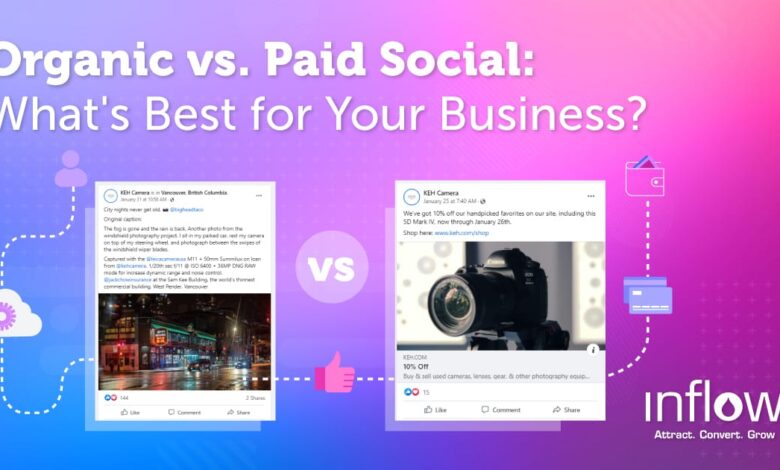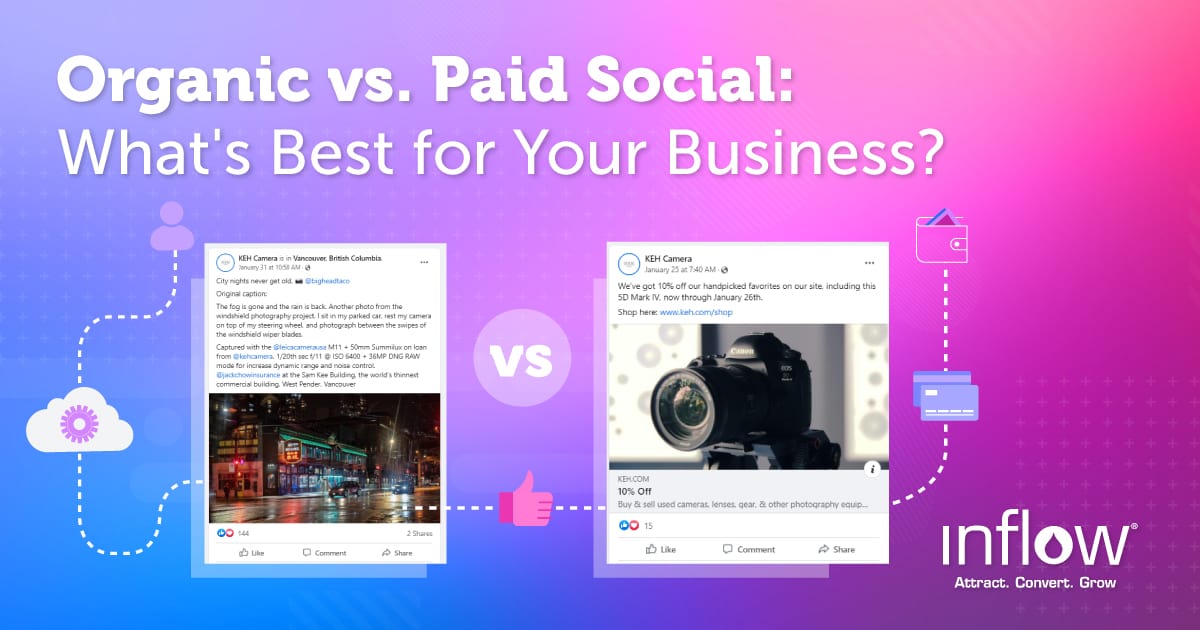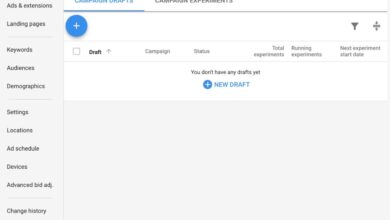
Organic vs Paid Social Finding the Balance
Organic vs paid social media finding the right balance is crucial for modern marketing success. Understanding the distinct characteristics of each approach, from content creation to ad campaigns, is essential. This guide explores the nuances of organic and paid strategies, from crafting compelling content to optimizing ad spend, helping you unlock the full potential of your social media presence.
This exploration delves into the core differences between organic and paid social media, outlining how to create effective strategies for each. We’ll cover building an engaging organic presence, maximizing paid campaigns, and integrating both for a holistic approach. Finally, we’ll discuss measuring your results and adapting your strategies for ongoing success.
Defining the Landscape
Social media marketing is a dynamic arena, constantly evolving with new platforms and trends. Understanding the nuances between organic and paid strategies is crucial for crafting a successful social media presence. This section delves into the core differences, tactics, ROI expectations, and key metrics for each approach.Organic social media relies on building a genuine connection with your audience through engaging content and fostering community.
Paid social media, on the other hand, leverages targeted advertising to reach a wider audience and drive specific actions, like conversions or website traffic.
Core Differences Between Organic and Paid Strategies
Organic strategies are primarily focused on building a following and fostering engagement. Content creation, community management, and platform-specific optimization are key components. Paid strategies, in contrast, prioritize targeted advertising to reach a specific demographic or audience segment. This often involves meticulous ad copywriting, compelling visuals, and strategic campaign management.
Examples of Organic and Paid Tactics
Organic social media tactics include posting high-quality blog posts, creating engaging videos, sharing user-generated content, and actively participating in relevant conversations. Paid tactics span a range of options, including running targeted ads on platforms like Facebook, Instagram, and Twitter. These ads can take various forms, from image ads to video ads to carousel ads, all designed to drive traffic to a landing page or achieve a particular objective.
ROI Expectations
The return on investment (ROI) for organic and paid social media strategies differs significantly. Organic strategies often yield a slower, more gradual ROI, focused on long-term brand building and audience growth. Paid strategies, in contrast, typically offer a more immediate and quantifiable ROI, although the cost of acquisition can be higher and necessitates continuous monitoring. For example, a brand that focuses heavily on organic growth might see a steady increase in website traffic over months.
Figuring out the perfect blend of organic and paid social media strategies can be tricky. It’s all about finding the right balance, and sometimes, a little help from specialized tools is key. For example, LinkedIn Showcase Pages, like linkedin showcase pages highlight your brand s best , are fantastic for showcasing specific brand aspects, which can boost your organic reach and make paid campaigns more targeted and effective.
Ultimately, organic and paid strategies need to work together to maximize your social media impact.
A brand utilizing paid strategies could see a spike in website traffic within days of launching a targeted ad campaign.
Metrics for Tracking Success
Several metrics are used to measure the success of both organic and paid social media campaigns. For organic campaigns, engagement metrics like likes, shares, comments, and reach are crucial. Tracking website traffic originating from social media is also essential. Paid social media campaigns, however, are typically evaluated using conversion rates, cost per acquisition (CPA), click-through rates (CTR), and return on ad spend (ROAS).
Comparative Analysis
| Characteristic | Organic Social Media | Paid Social Media |
|---|---|---|
| Goal | Brand awareness, audience growth, engagement | Lead generation, conversions, sales |
| Timeframe | Long-term | Short-term to medium-term |
| Cost | Low (primarily time and resources) | High (advertising budget) |
| Control | Limited by platform algorithms | Higher level of control over targeting and messaging |
| Metrics | Reach, engagement, website traffic | Conversion rate, CPA, ROAS, CTR |
Building an Effective Organic Strategy
Organic social media presence is crucial for long-term brand building and audience engagement. It’s about fostering genuine connections and building trust through consistent, valuable content, rather than relying on paid promotion. A strong organic strategy lays the foundation for a sustainable social media ecosystem.Crafting an effective organic strategy involves more than just posting pretty pictures. It requires a deep understanding of your target audience, a consistent content calendar, and a keen eye for analytics.
Organic reach requires effort and patience, but the rewards are worth it.
Defining Your Target Audience
Understanding your target audience is paramount to creating content that resonates. Knowing their demographics, interests, pain points, and online behavior allows you to tailor your content for maximum impact. Thorough market research and social listening are essential steps in this process.
Creating Engaging Content
Content creation is the heart of any successful organic strategy. It’s not just about quantity, but quality. Engaging content captures attention, sparks conversations, and encourages interaction.
- High-Quality Visuals: Images and videos are powerful tools for capturing attention. Invest in professional-quality visuals that align with your brand aesthetic. Use high-resolution images and videos that are optimized for the platform.
- Compelling Storytelling: Weave narratives around your brand and products. Use stories to connect with your audience on an emotional level. Share behind-the-scenes glimpses, customer testimonials, and brand journeys to build trust.
- Thought-Provoking Questions: Engage your audience with thought-provoking questions. Encourage discussions and foster a sense of community. Polls and quizzes can also be highly effective.
- Interactive Content Formats: Utilize interactive content formats like polls, quizzes, Q&A sessions, and live streams to boost engagement. These formats encourage audience participation and foster a sense of community.
Optimizing Content for Organic Reach
Optimizing content for organic reach goes beyond just aesthetics. It involves strategic use of s, hashtags, and platform-specific best practices. Understanding algorithm updates and trends is vital for staying ahead of the curve.
- Research: Conduct thorough research to identify relevant s and phrases that your target audience uses. Use these s strategically in your captions, descriptions, and hashtags.
- Hashtag Strategy: Use relevant hashtags to increase visibility and reach a wider audience. Avoid excessive use of hashtags, and focus on a curated list of relevant hashtags.
- Platform-Specific Best Practices: Each social media platform has its own unique algorithm and best practices. Familiarize yourself with the specific requirements and guidelines for each platform to optimize your content.
- Posting Consistency: Regular posting schedule helps keep your audience engaged and informed. Consistent posting is a key aspect of organic reach, fostering audience familiarity and anticipation.
Avoiding Pitfalls in Organic Social Media
Building a strong organic social media presence requires attention to detail and proactive avoidance of common pitfalls.
- Lack of Planning: Without a clear strategy, your efforts will be scattered and ineffective. Develop a content calendar to maintain consistency and focus.
- Ignoring Analytics: Track your results to understand what works and what doesn’t. Regular analysis of your data will help you make informed decisions.
- Ignoring Audience Feedback: Engage with your audience and respond to comments and messages promptly. Actively listen to audience feedback to tailor your content.
- Poor Quality Content: Ensure high-quality visuals and compelling content. Poor quality content can negatively impact your brand image.
Content Format Comparison, Organic vs paid social media finding the right balance
Different content formats can effectively engage various audiences. The following table highlights the effectiveness of different formats.
| Content Type | Description | Target Audience | Example |
|---|---|---|---|
| Images | Visual representations of products, ideas, or concepts. | Broad audience, especially visual learners. | Product photos, infographics, inspirational quotes. |
| Videos | Moving visuals that tell stories or demonstrate processes. | Wide range of audiences, especially those who prefer video content. | Product demos, behind-the-scenes footage, tutorials. |
| Stories | Ephemeral content that allows for real-time engagement. | Audiences who appreciate real-time updates and behind-the-scenes content. | Live Q&A sessions, behind-the-scenes glimpses, polls, quizzes. |
| Carousels | Collections of images or videos in a single post. | Audiences who prefer visually rich content. | Product showcase, step-by-step tutorials, multi-image stories. |
Maximizing Paid Social Media Campaigns: Organic Vs Paid Social Media Finding The Right Balance
Paid social media campaigns are a powerful tool for reaching a targeted audience and driving measurable results. While organic strategies build a foundation, paid campaigns can accelerate growth and achieve specific marketing goals more quickly. This section will delve into the framework for creating effective paid social media campaigns, emphasizing the importance of clear objectives and the various ad formats available.Understanding the nuances of audience targeting and segmentation, as well as the cost considerations associated with each platform, are crucial for success.
By strategically utilizing paid advertising, businesses can achieve significant returns on investment while maximizing their social media presence.
Finding the right balance between organic and paid social media strategies is key. While organic efforts are important for building a genuine community, sometimes a boost is needed. Learning how to schedule Instagram posts effectively can be a game-changer in your social media strategy. how to schedule instagram posts and why you should is a great resource for understanding the ins and outs of efficient scheduling.
Ultimately, it all comes down to figuring out the best approach for your brand and budget to maximize your reach and engagement on social media.
Defining Clear Objectives for Paid Campaigns
Defining clear objectives is paramount to the success of any paid social media campaign. Vague goals lead to wasted budget and ineffective results. A well-defined objective provides a roadmap for campaign strategy, ensuring that all efforts are focused on achieving specific, measurable outcomes. Examples of measurable objectives include increasing website traffic, generating leads, boosting brand awareness, or driving sales.
By aligning campaign activities with quantifiable goals, businesses can track progress and optimize performance.
Setting Up and Managing Paid Social Media Campaigns
A structured approach to setting up and managing paid social media campaigns is crucial for maximizing ROI. This involves a phased process. First, detailed planning and strategy are needed. This includes identifying target audiences, selecting relevant platforms, and defining specific KPIs (Key Performance Indicators). Second, campaign creation involves setting up ad creatives, budgets, and scheduling.
Thorough A/B testing is a critical component for optimization. Finally, consistent monitoring and analysis are vital. Campaign performance needs to be assessed regularly, and adjustments made as necessary to maintain effectiveness.
Social Media Ad Formats and Applications
Different social media platforms offer various ad formats, each with its unique strengths and applications. Understanding these formats is key to tailoring campaigns for optimal results.
- Image Ads: Simple, visually engaging ads that can be highly effective for driving brand awareness or showcasing products. These ads are often used for showcasing products or services visually.
- Video Ads: Captivating video content is often more engaging than static images. They can be used to tell a story, demonstrate a product, or build brand identity. Video ads are especially well-suited for platforms like YouTube and Instagram.
- Carousel Ads: These ads allow multiple images or videos to be presented in a single ad unit, providing a richer experience for users. This is helpful for showcasing multiple product options or highlighting different aspects of a service.
- Collection Ads: Designed to showcase multiple products from a brand, these ads allow users to browse and purchase items directly within the ad. They are particularly effective for e-commerce businesses.
- Stories Ads: These ads appear within the platform’s story format, which typically offers more interactive and engaging experiences for users. They are perfect for capturing attention and driving immediate engagement.
Audience Targeting and Segmentation
Understanding your target audience is essential for paid social media success. This goes beyond simple demographics. Thorough audience segmentation considers psychographics, interests, behaviors, and needs. By segmenting audiences, you can create highly targeted campaigns, ensuring that your message reaches the right people. This precision increases the likelihood of conversions and maximizes your return on investment.
Social Media Platforms and Ad Options
The following table highlights the key differences between various social media platforms and their ad options.
| Platform | Ad Types | Target Audience | Cost Considerations |
|---|---|---|---|
| Image, Video, Carousel, Collection, Stories | Broad, highly segmented, demographics, interests | CPM (Cost Per Mille) and CPC (Cost Per Click) vary based on targeting and competition | |
| Image, Video, Carousel, Stories, Shopping | Visual-focused, younger demographics, influencers | Similar cost considerations to Facebook, with potentially higher costs for highly competitive niches | |
| Image, Video, Promoted Tweets | Real-time engagement, news-oriented, conversations | CPC (Cost Per Click) is common, often influenced by trending topics and s | |
| Text Ads, Sponsored Content, Video | Professionals, businesses, B2B audiences | CPM (Cost Per Mille) and CPC (Cost Per Click), often higher than other platforms for specific, targeted audiences | |
| TikTok | Video, Branded Effects, Challenges | Gen Z, younger audiences, trend-focused | CPC (Cost Per Click) and CPM (Cost Per Mille), competitive pricing, cost depends on reach and engagement |
Integrating Organic and Paid Approaches

A truly effective social media strategy recognizes the complementary nature of organic and paid efforts. Simply put, they shouldn’t be viewed as separate entities but rather as interconnected components working in concert to achieve shared goals. This integrated approach allows for broader reach, targeted messaging, and a more comprehensive understanding of audience engagement.Combining organic and paid strategies allows brands to maximize their return on investment (ROI) by leveraging the strengths of each approach.
Organic content builds brand awareness and fosters community, while paid advertising amplifies these efforts by reaching a wider audience and driving targeted traffic to desired destinations, such as product pages or landing pages.
Figuring out the perfect blend of organic and paid social media strategies can be tricky. Knowing how to best present your content is key, and mastering blog post formatting, like using headings and bullet points, is super important for readability. Check out these blog post formatting tips enhance readability to boost your engagement. Ultimately, understanding how to structure your content, whether it’s for a blog post or a social media post, will help you reach a wider audience and find the sweet spot between organic and paid efforts.
Leveraging Paid Campaigns to Amplify Organic Efforts
Paid social media campaigns are powerful tools for amplifying the impact of organic content. They can boost the visibility of engaging posts, increase engagement metrics like likes, shares, and comments, and drive traffic to important pages. For instance, a paid campaign promoting a visually appealing organic blog post can significantly increase its reach and engagement.
Examples of Successful Brand Integration
Numerous brands have successfully combined organic and paid strategies to achieve notable results. For example, a clothing retailer might use paid ads to promote a new collection, directing traffic to a landing page. Simultaneously, they could leverage user-generated content and reviews (organic) to build trust and social proof, thereby further boosting sales conversions. Another example is a food brand using paid social media to drive awareness of a new recipe, followed by organic posts that include the recipe and encourage user-generated content through recipe submissions and tagging.
Evaluation Method for Combined Approach
Evaluating the effectiveness of an integrated organic and paid strategy requires a multifaceted approach. Track key metrics such as website traffic, lead generation, brand mentions, and overall engagement. Monitor how paid campaigns influence organic performance and vice-versa. A/B testing different ad creatives and organic content formats can also provide valuable insights into what resonates best with the target audience.
Tools and platforms dedicated to social media analytics offer a detailed view of the engagement metrics and their correlation. A critical aspect of the evaluation process is comparing the results of the integrated strategy against past performance metrics and benchmarks for the industry.
Multi-Channel Social Media Strategy
A well-structured multi-channel strategy ensures a consistent brand message and engagement across various platforms. The table below Artikels a potential framework for integrating organic and paid approaches across different social media channels.
| Platform | Organic Strategy | Paid Strategy | Measurement Metrics |
|---|---|---|---|
| Engaging posts, community building through groups, contests, and interactive content. | Targeted ads, boosted posts, promoted content, lead generation ads. | Reach, engagement (likes, shares, comments), website clicks, conversions, cost per acquisition (CPA). | |
| High-quality visuals, stories, reels, collaborations with influencers, behind-the-scenes content. | Targeted ads, influencer collaborations, carousel ads, shopping ads. | Reach, engagement (likes, comments, saves), website clicks, conversions, brand mentions. | |
| Engaging in relevant conversations, sharing insightful content, responding to mentions, participating in trends. | Targeted ads, promoted tweets, trending topics, and relevant conversations. | Reach, engagement (retweets, replies, likes), website clicks, impressions. | |
| Sharing industry insights, thought leadership content, participating in relevant groups, networking. | Targeted ads, sponsored content, InMail campaigns. | Reach, engagement (comments, shares, likes), website clicks, leads, thought leadership. |
Measuring and Adapting
Tracking the performance of your social media strategy, both organic and paid, is crucial for continuous improvement. A robust system for measuring key metrics allows you to identify what’s working, what’s not, and make informed decisions to optimize your efforts. This is not a one-time exercise; it’s an ongoing process that demands constant attention and adjustment.Understanding the effectiveness of your strategy hinges on a precise evaluation of your chosen metrics.
This involves more than simply looking at raw numbers; it’s about interpreting the data to gain insights into user engagement and campaign performance. By analyzing these insights, you can pinpoint areas where improvements are needed and refine your approach for better results.
Key Metrics for Evaluating Success
Analyzing your social media campaigns requires a multi-faceted approach, considering both qualitative and quantitative data. Crucial metrics include reach, engagement (likes, comments, shares, saves), website clicks, conversion rates, and brand mentions. Each metric provides a unique perspective on your campaign’s performance, helping you to identify strengths and weaknesses. For example, high reach might indicate broad awareness, but low engagement could signal a lack of resonance with your target audience.
Conversely, high engagement with low reach could indicate a highly targeted but smaller audience responding strongly to your content.
Analyzing Data to Identify Areas for Improvement
Regularly reviewing your data is essential for understanding the effectiveness of your strategy. This involves more than simply noting the numbers; it’s about identifying patterns and trends within the data. For instance, are certain types of content performing better than others? Are specific days or times more effective for posting? Identifying these trends allows you to adjust your approach and optimize your content calendar.
Tools like Google Analytics and social media platform analytics dashboards are instrumental in this process. They provide comprehensive insights into user behavior and campaign performance.
Adjusting Strategies Based on Performance Data
Data analysis isn’t just about identifying issues; it’s about finding solutions. If organic posts aren’t generating the desired engagement, consider adjusting the content style, topic, or posting schedule. If paid campaigns aren’t converting as expected, scrutinize the targeting parameters, ad creatives, or bidding strategies. A/B testing different variations of your content and ad creatives can reveal optimal approaches.
This iterative process allows you to continually refine your strategy based on the insights derived from the data.
Importance of Ongoing Monitoring and Optimization
Social media landscapes change rapidly. Keeping a close eye on your performance metrics ensures you’re staying ahead of the curve. This includes adapting to emerging trends, adjusting your content strategy, and continuously refining your paid campaigns. Consistent monitoring and optimization are vital for maintaining a competitive edge and ensuring your social media strategy remains aligned with your business objectives.
Detailed Example of a Social Media Performance Report
| Date | Platform | Metric | Value | Analysis |
|---|---|---|---|---|
| 2024-07-26 | Reach | 15,000 | High reach, indicating broad awareness. | |
| 2024-07-26 | Engagement (likes + comments) | 500 | Moderate engagement; further optimization of content could increase this. | |
| 2024-07-26 | Reach | 8,000 | Good reach, potentially indicating a well-targeted audience. | |
| 2024-07-26 | Retweets | 200 | High retweet rate, suggesting strong resonance with the audience. | |
| 2024-07-27 | Website Clicks | 300 | Positive response to paid campaign; potential for higher conversions. | |
| 2024-07-27 | Conversion Rate | 2% | Conversion rate needs improvement; consider refining targeting and ad creatives. |
Case Studies and Best Practices

Social media is a dynamic landscape, constantly evolving. To truly leverage its power, understanding successful strategies employed by leading brands is crucial. Analyzing case studies reveals actionable insights, showcasing how brands adapt their approach to achieve remarkable results. This section delves into real-world examples of organic and paid campaigns, highlighting best practices for diverse industries and target audiences.
Real-World Examples of Successful Campaigns
Numerous brands have successfully harnessed the potential of social media, demonstrating effective strategies that can be applied to various businesses. These examples illustrate the power of targeted content, consistent engagement, and insightful analytics.
- Nike’s “Dream Crazier” campaign: This campaign, utilizing both organic and paid strategies, resonated with a broad audience. The campaign emphasized female empowerment through inspiring narratives and user-generated content, leading to significant brand awareness and positive sentiment. This highlights the importance of a strong narrative that aligns with brand values.
- Dollar Shave Club’s viral video: This humorous and unconventional video quickly went viral, generating significant organic reach and driving substantial customer acquisition. The campaign effectively leveraged the power of a unique and engaging video format to capture attention and establish a strong brand identity.
- Patagonia’s commitment to environmentalism: Patagonia’s organic social media presence is built on their consistent commitment to environmentalism. By actively engaging with their audience on issues important to them, they build trust and loyalty, demonstrating that authenticity resonates deeply with consumers.
Strategies Used by Leading Brands
Successful social media strategies often involve a blend of creativity, consistency, and adaptation. Leading brands utilize various tactics to engage audiences and drive desired outcomes.
- Content Pillars and Consistency: Brands often identify key content pillars that align with their brand values and target audience. This allows for a more consistent and engaging social media presence, maintaining a recognizable tone and style. Creating a content calendar can help streamline this process.
- Targeted Advertising and Audience Segmentation: Paid social media strategies often leverage detailed audience targeting to ensure campaigns reach the most relevant demographics. This targeted approach maximizes the return on investment by concentrating resources on individuals most likely to convert.
- Community Building and Engagement: Brands actively foster a sense of community by responding to comments, engaging in conversations, and hosting interactive sessions. Creating opportunities for two-way communication is vital for strengthening brand loyalty and fostering advocacy.
Adapting Strategies to Specific Industries
The effectiveness of a social media strategy is heavily influenced by the industry and target audience. Tailoring approaches to specific niches is crucial for maximizing results.
- Fashion Brands: Visual content plays a significant role, using high-quality images and videos to showcase products. Influencer collaborations and visually engaging content are often key strategies.
- Tech Companies: Educational content, behind-the-scenes glimpses, and interactive demonstrations are often effective. Transparency and a focus on innovation can build trust.
- Food and Beverage Brands: Appealing visuals, interactive content like polls and quizzes, and user-generated content are effective. Highlighting the experience of consuming the product or service is key.
Applying Strategies to Your Business
The principles of successful campaigns can be applied to any business. Understanding the industry and target audience is essential for tailoring strategies.
| Industry | Brand | Strategy | Results | Key Takeaway |
|---|---|---|---|---|
| Fashion | ASOS | High-quality product photos, influencer collaborations, targeted advertising | Increased brand awareness, boosted sales | Visual appeal and influencer marketing are effective in fashion |
| Technology | Apple | Behind-the-scenes content, showcasing innovation, influencer marketing | Strong brand image, positive customer sentiment | Transparency and showcasing innovation are crucial in technology |
| Food & Beverage | Starbucks | Visual content, user-generated content, interactive contests | Increased engagement, positive brand perception | Visual appeal and community building are important for food & beverage |
Final Review
Ultimately, achieving the right balance between organic and paid social media requires a deep understanding of your target audience, clear objectives, and a willingness to adapt and refine your strategy based on performance data. By integrating both organic and paid approaches, you can cultivate a powerful social media presence that drives engagement, fosters brand loyalty, and ultimately, achieves your business goals.
The key is understanding the strengths of each and leveraging them effectively.





